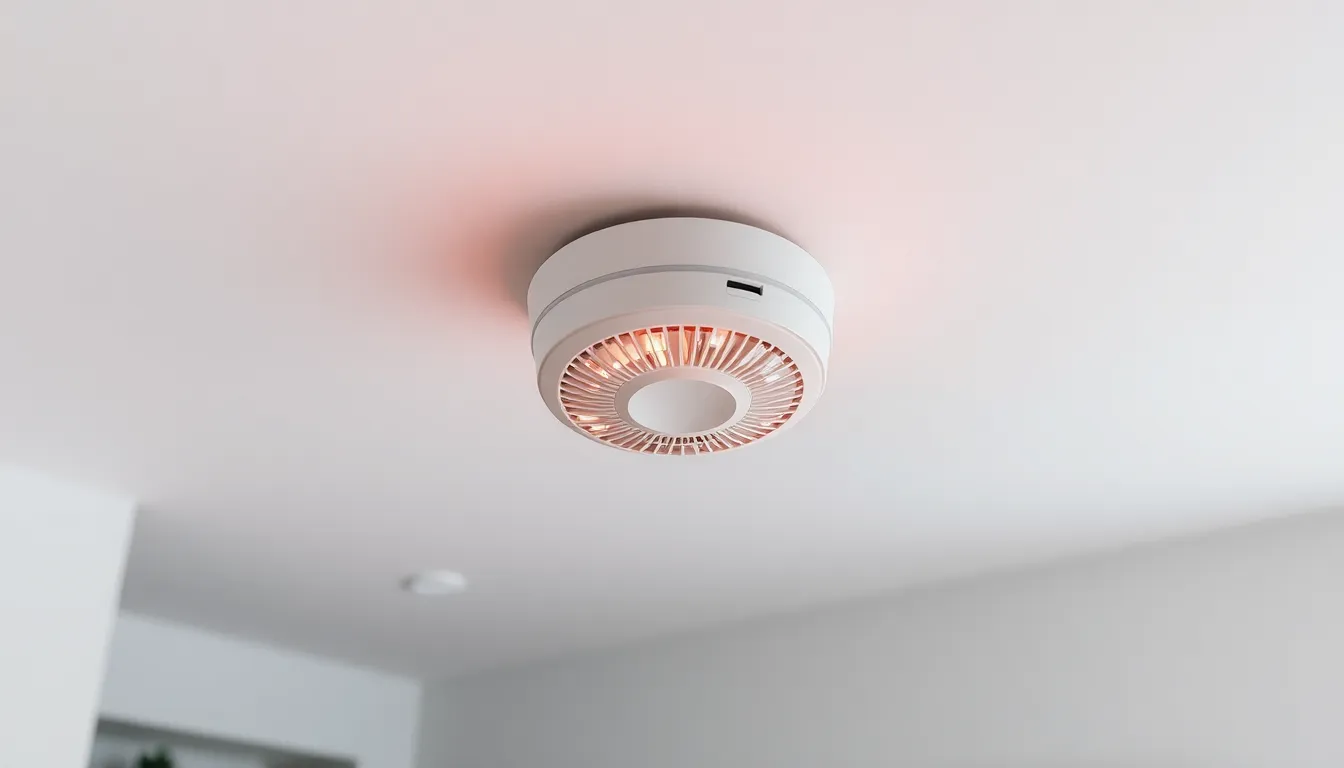In a world where smart devices rule our lives, why should fire detection be left in the stone age? Enter IoT fire detection—a game changer that’s not just about smoke alarms beeping at the most inconvenient times. Imagine a fire detection system that not only alerts you but also sends a message to your phone while you’re blissfully binge-watching your favorite show. It’s like having a personal fire-fighting assistant who knows when to interrupt your popcorn munching!
With the rise of the Internet of Things, fire safety has never been more advanced. These systems use smart technology to monitor environments in real time, ensuring that safety is always a click away. Whether it’s your home or business, IoT fire detection offers peace of mind and a dash of high-tech flair. So why settle for outdated methods when you can embrace the future of fire safety?
Table of Contents
ToggleOverview of IoT Fire Detection
IoT fire detection represents a significant advancement in fire safety technology. These systems utilize interconnected devices to enhance monitoring and response capabilities.
What is IoT Fire Detection?
IoT fire detection uses smart devices connected to the internet to identify fires. Sensors detect smoke, heat, or gas emissions, sending alerts to designated smartphones or monitoring systems. Cloud-based platforms store and analyze data, providing insights on potential hazards. Notifications are instant, enabling quicker responses to emergencies. Users can remotely monitor their premises, ensuring safety even when away.
Importance of Fire Detection Systems
Fire detection systems play a crucial role in safeguarding lives and property. Every year, fires cause significant economic losses, with the National Fire Protection Association reporting over $14 billion in damages annually. These systems provide early warning, substantially increasing survival rates. Rapid alerts allow occupants to evacuate quickly, while timely notifications can inform emergency services. In commercial settings, reliable fire detection systems minimize disruption and potential legal liabilities. Investing in advanced IoT technologies ensures enhanced fire safety and peace of mind.
Key Components of IoT Fire Detection
IoT fire detection relies on several essential components that ensure effective monitoring and rapid response. Each plays a crucial role in maintaining safety and enhancing capabilities.
Sensors and Devices
Sensors and devices form the backbone of IoT fire detection systems. These include smoke detectors, heat sensors, and gas leak detectors. Smoke detectors use optical or ionization technology to identify smoke particles in the air. Heat sensors monitor temperature changes, triggering alerts when excessive heat is detected. Gas leak detectors sense hazardous gases like carbon monoxide and natural gas, alerting users instantly to potential dangers. Each device communicates information to a centralized system, ensuring a coordinated response. By integrating multiple sensors, these systems enhance detection accuracy and improve user safety.
Data Communication Technologies
Data communication technologies facilitate seamless interaction between devices in IoT fire detection systems. Wireless protocols such as Wi-Fi, Zigbee, and LoRaWAN enable real-time data transmission. Wi-Fi often provides robust connectivity for smart devices within homes or businesses. Zigbee, on the other hand, offers low power consumption, making it ideal for battery-operated sensors. LoRaWAN excels in long-range communications, particularly useful in large commercial settings. These technologies ensure that alerts reach users’ smartphones rapidly, enhancing responsiveness during potential fire incidents. By utilizing various communication methods, IoT fire detection maximizes coverage and reliability.
Advantages of IoT Fire Detection
IoT fire detection systems bring numerous benefits that enhance overall fire safety.
Real-Time Monitoring
Real-time monitoring allows users to receive immediate alerts about potential fire hazards. Devices continuously assess conditions, detecting smoke or temperature changes promptly. Alerts reach smartphones instantly, ensuring users stay informed even while away. Remote access lets them monitor their property anytime, increasing peace of mind. Statistics indicate that timely notifications reduce response times significantly, which ultimately increases the likelihood of effective intervention. Real-time monitoring also helps businesses maintain operational safety, minimizing downtime due to fire-related incidents.
Enhanced Safety Features
Enhanced safety features make IoT fire detection systems superior to traditional alarms. These systems incorporate advanced sensors that distinguish between false alarms and genuine threats. Smart technology learns from user behavior and environmental patterns, leading to more accurate readings. Multiple sensors communicate seamlessly, ensuring comprehensive coverage throughout a building. Collaborative features allow for integration with other safety systems, such as sprinklers and alarms. This interconnectedness amplifies overall safety measures, reducing the risk of devastating fire damage.
Challenges and Limitations
IoT fire detection systems face several challenges and limitations that impact their effectiveness.
Technical Challenges
Integrating various devices and communication protocols presents significant technical hurdles. Diverse manufacturers produce sensors that may not be compatible, which complicates system cohesion. Reliability hinges on stable internet connections, making systems vulnerable in areas with weak signals. False alarms can arise from sensor inaccuracies, diminishing user trust. Maintenance and updates require specialized knowledge to ensure all components function optimally. Moreover, power failures can disrupt notifications, leaving properties unmonitored when they need protection the most. Ensuring seamless interoperability among all devices stands as a critical challenge for deploying effective solutions in different settings.
Privacy and Security Concerns
IoT fire detection systems inherently raise privacy and security issues. With devices connected to the internet, unauthorized access becomes a real threat. Hackers could manipulate systems, create false alarms, or disable alerts entirely. Protecting user data from breaches, especially sensitive information linked to home automation, requires robust encryption methods. Compliance with privacy regulations, such as GDPR, is essential when handling personal data. Users often hesitate to adopt these systems due to fears of surveillance or data misuse. Addressing these concerns through transparency and secure design practices is crucial for building trust among potential users.
Future Trends in IoT Fire Detection
The future of IoT fire detection lies in further innovations and integrations that elevate safety measures. Emerging technologies continue to shape this field, offering enhanced features and capabilities.
Integration with Smart Buildings
Integration of IoT fire detection systems with smart buildings enhances overall safety and efficiency. Smart buildings use interconnected devices to manage resources effectively, and fire detection systems play a crucial role in this network. Advanced sensors communicate with building management systems to trigger automatic responses when hazards are detected, whether it’s activating alarms or notifying emergency services. These systems can adapt in real-time, reducing response times significantly. Using smart features, building managers can track fire detection performance, ensuring all systems function optimally. Incorporating fire detection into smart buildings leads to safer environments for occupants while maximizing operational efficiency.
Advancements in AI and Machine Learning
Advancements in artificial intelligence and machine learning are revolutionizing IoT fire detection. These technologies analyze vast amounts of data from various sensors, improving threat detection accuracy. Instead of relying solely on traditional signal triggers, AI algorithms can discern patterns that indicate fire risks, leading to faster and more reliable alerts. Machine learning models evolve continuously, allowing them to reduce false alarms significantly. Automated assessments of environmental conditions ensure consistent monitoring, providing greater peace of mind. As AI capabilities grow, the potential for predictive analytics in fire safety becomes more pronounced, enabling proactive measures to mitigate risks. These innovations promise a future where fire detection systems are smarter and more responsive than ever before.
Conclusion
The integration of IoT technology into fire detection systems marks a transformative leap in safety and monitoring. With real-time alerts and enhanced sensor capabilities, these systems provide a level of protection that traditional alarms simply can’t match. As users embrace the convenience of smart notifications and remote monitoring, the importance of investing in advanced fire detection solutions becomes clear.
While challenges exist, including technical integration and security concerns, the benefits far outweigh the drawbacks. The future of fire safety is bright, with innovations like AI and smart building integration paving the way for even more effective solutions. Investing in IoT fire detection is not just a choice; it’s a critical step toward safeguarding lives and property in an increasingly connected world.







